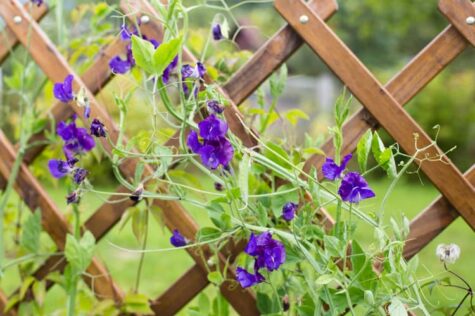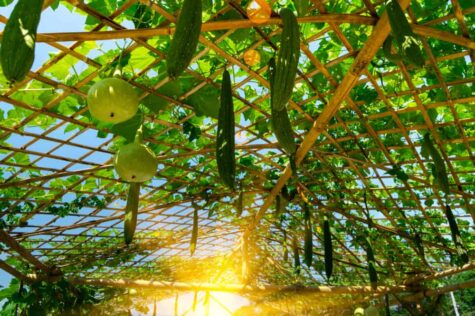Nasturtiums love to climb up a trellis or any natural stem, these plants reach for the sun!
The cheerful blooms of nasturtiums thrive in the poorest of soils, winding themselves in intricate shapes around anything that will allow them to climb.
Nasturtiums are wonderful climbers which will delight your eyes for months. Let’s look at 4 of the best ways to trellis them:
4 ideas for trellising nasturtiums
1. Wooden trellis is ideal for pot nasturtiums
Place it on a wall behind the pot and the plant will curl itself around the trellis with ease.

Credit: Islandashley
You can help the plant by curling it onto the trellis if it doesn’t find it to start with. This provides the nasturtium with support and you with brightly coloured flowers to enjoy all summer long.
2. Bamboo poles can work well too
If you plant nasturtiums with French beans, runner beans or any climbing beans, many pests are attracted to the gorgeous flowers. Aphids in particular will flock to nasturtiums by choice, which means they leave your bean flowers and leaves alone. A fantastic combination!
Nasturtiums are often chosen as companion plants because white fly, aphids and other pests adore them. Experienced vegetable gardeners know that the yellow and orange flowers are also really attractive to pollinators so you can help the bees as well. The trellis for the runner beans transforms into a nasturtium climber. So the aphids devour the nasturtium, leaving the beans to grow well without too many worries.
3. Climb a vine and add colour
If you have a vine in your garden or under cover, at times the trunks can seem brown and bare in summer so plant nasturtiums! Seeded in soil at the base of a vine, they will climb as vigorously as the grape vines, adding a fantastic dash of colour to any garden, as they grow.
They climb vines and twine around it beautifully adding a decorative look to the vine as it grows. Colours can vary from yellow to lemon yellow to bright orange and their cheerful tubular shapes can be enjoyed until the first frosts.

Credit: Siena Scarff
Like the vine pictured, they do not need really nutritious soil. In fact, if the soil is too full of nutrients, the nasturtium plant tends to grow expansive foliage rather than blooms. The heart shaped leaves are edible in salads with a spicy tang to taste as are the flowers. Decide if you want to encourage flowers or foliage though and bear this in mind when choosing the soil.
4. Cover up areas with nasturtiums
Use a support system like the edges of your composting area as a trellis, and you can disguise the area beautifully by the climbing stems of nasturtiums. They last the whole summer even until the misty days of November, providing bright colour, pollen and salad leaves in the autumn at a time when very little else is in bloom.
Nasturtiums can cover a compost heap, fence or a garden shed to transform an area into a colourful place to enjoy.

Nasturtium flowers and leaves are edible and can be added to salads. Credit: Shutterstock
Best conditions for growing nasturtiums
Now read on for advice about the best conditions, soil and how to care for nasturtiums.
Soil: Strangely enough, nasturtiums love poor soil. If the soil is very rich the nasturtium will produce lots of foliage. So if you want colourful flowers, then ensure that the seeds are placed in soil that has not been fertilised or had beans or peas the previous season. This is because these legumes add nitrogen as they grow, which encourages plants to grow. Traditionally cabbages follow beans as they need extra nutrition right through the growing season and even before.
Temperature: These colourful blooms are good from June through to the first frosts.
Fertiliser: There is no need to add extra fertiliser for nasturtiums. In fact, if you do, you will gain a lot of leaves but very few flowers.
Water: These plants can survive a drought. If they are outdoors they hardly need to be watered all summer provided that there has been occasional rain. If you notice the plant drooping, water well or use your leftover grey water like washing up water or what’s left after washing some earthy newly picked potatoes.

Save this pin for later







I am going to grow a Nasturtium in a pot and want to know if it will up and over an archway. Also, will it need pruning, Thanking you.
Hi Lee, great to hear from you! Nasturtiums love growing in pots and they can climb very high – over 6 feet here in the UK. Just make sure the soil is quite poor as the flowers don’t grow well in really rich soil but leaves do. I advise growing 2 plants in pots either side of your archway. That way you will have flowers on both sides. Re pruning, it’s not usually necessary. Just drape the growth into the support, tie it in loosely if you like and it will continue to grow well. You won’t need to water it much either but in a heatwave, check the soil regularly and give it a really good soaking about once a week. Let me know how it grows and send us a pic if you like. All the best. Tina
The leaves of my nasturtium are covered with a white mold or fungus. What should I do? Cut to the base and start over?
Good morning Hannah. Poor you! It looks quite unsightly, doesn’t it? I would advise several things.
– Definitely cut off the leaves and make sure you do not add these into your compost heap as they may spread disease in there.
– The fungus may be caused by Botrytis, which causes gray, mouldy leaves and generally happens when the weather has been wet and damp.
– If you are growing your nasturtiums near tomatoes or potatoes, they may have blight, which can also cause grey mouldy and diseased leaves. This is highly infectious so check plants growing nearby.
– A simpler cause could be that you are over watering. Stop watering for a few days, remove the leaves and pray for some sunshine! If new leaves do not seem damaged, then stop watering so frequently.
– A word of caution if you do identify tomato or potato blight. To stop it spreading, cover affected plants with a polythene bag to keep disease in there and burn the whole plant. Do not plant potatoes or tomatoes in that soil for at least 3-4 years just in case.
I really hope it is just a damp weather patch causing you problems and that your nasturtiums return to health soon. If you live in the south of the UK, planting some seeds now will mean a new supply until the first frosts so it may be worthwhile.
All the best and enjoy the rest of the summer in the garden.
Tina
Hello Tina, my goodness I am just replying to your email of March this year. I couldn’t find the page where I asked you about growing Nasturtiums in a pot to grow over an arch. Well I have started growing them in a pot on each side of the arch and now that the Autumn is over (here in Australia) they are starting to grow. I have planted a Jewel Mix and going to plant Empress of India which looks really lovely on the packet. Thank you for replying and I must apologise for taking so long. I will have to learn how to send a photo when it is ready.